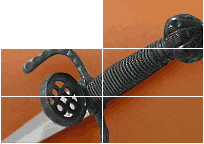Vince Evans Early Scottish Dirk
Original: Scotland, early 18th century

The
Scottish dirk developed from the dudgeon dagger and
ballock dagger and shares many features with them. Early specimens show the characteristic rounded haunches of their predecessors and had little to no decoration save for perhaps a simple interlaced knot-worked band at the top and bottom of the grip.
The dirk presented here is an example of an early piece of work by Hammerman Vince Evans. Like the early dirks that history has left us, the hilt of this piece has carving of a simplified form when compared to the fully-developed dirks of later years.
The grip is made from a beautiful honey-colored wood and has a prominent swelling at its center where two separate interlaced bands are carved in high relief. A strap of brass reinforces each of the haunches and a carved
trefoil knot sits between them. A straight guard plate joins the hilt to the blade. The pommel cap is made of brass and is topped with a square peen block.
Many early dirks have blades made out of recycled sword blades. This dirk has a style mimicking a cut-down backsword blade and has a spatulate tip with its back-edge ground down to create a 4-inch long sharpened false-edge. A wide fuller extends from the thick spine to half the blade's width and runs down the entire length almost to the tip. A Passau
running wolf mark acts as yet another clue that this dirk would have been made from a German sword blade.
The scabbard is a simple affair with a wooden core, covered in brown leather, and mounted with a brass throat and tip. A leather suspension connects to a ring at the back.
Overall length: 15.75"
Weight: 9 ounces
Width of guard: 1.375"
Blade: 10.875" long; 1.125" wide tapering to .875"
Grip and pommel: 4.625" long
Maker:
Vince Evans of Hawaii.
This item has been retired from the collection.


